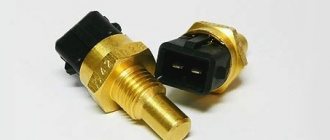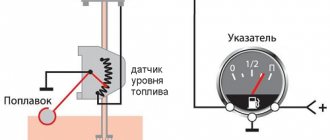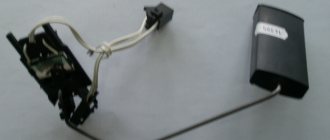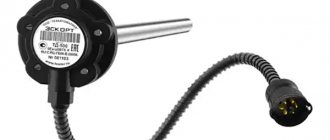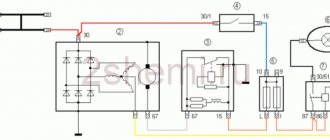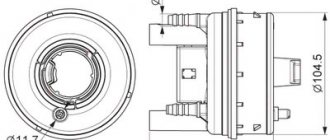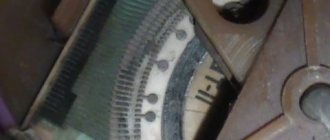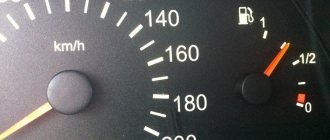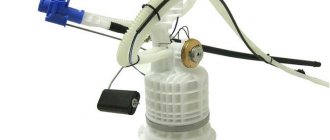What to do in such cases?
If the fuel level sensor shows an incorrect value, there are several ways to solve the problem.
It is necessary to adjust the device itself:
- First way. The spoke of the float that you replaced must be moved from one extreme position to the other. As you understand, in this case the arrow readings on the instrument panel should also vary from one position to another. In this case, you may need the help of another person. If you notice that when you move the spoke, the arrow on the dashboard shows the wrong value, you will need to slightly bend one of the adjusting tabs.
The arrow shows a full tank
- Second way. You will need to adjust the gas level on the dashboard. To do this, you will need to disassemble the dashboard. Accordingly, first you should turn off the ignition. The gasoline sensor arrow should be removed, after which all the wire blocks must be reconnected to the “tidy”, without installing it in place. Having done this, turn the key in the ignition, but do not start the engine. Wait about 10 minutes. After this, the spoke of the regulator itself should be moved to the position corresponding to an empty tank (if there is no gasoline in it) or full (if the tank is completely filled). Fix the arrow, install the “tidy”, then turn off the ignition and turn it on again.
- You can also test the instrument panel if you think there is a broken contact somewhere. Hold down the daily mileage reset button while turning the ignition key, and then release the button. In this case, all the arrows on the “tidy” must move along their scales. If this does not happen, then the problem is in the panel itself.
- Another option is to disconnect the connector that goes to the fuel sensor and watch the arrow. If it lies in the position indicating the absence of fuel, then the sensor is undoubtedly shorted.
If your car is equipped with an on-board computer, then it would not be a bad idea to diagnose it.
Conditions for correct operation
If you have not previously encountered electrical devices and do not know how the fuel level indicating system works, familiarize yourself with the following concepts:
Most systems for indicating the fuel level in a tank operate on the same principle. There is a float in the tank, on the counterpart of which there is a sliding contact. The sliding contact moves along a plate with contacts (resistive substance), rigidly fixed to the meter body. Moving the sliding contact changes the resistance value, thereby increasing or decreasing the amount of current passing in the circuit. The lower the resistance, the more current flows in the circuit and the more the fuel level indicator needle deviates.
Malfunctions
For what reasons may the fuel level indicator not work:
- lack of good contact on any part of the circuit (breaking off wires, oxidation at the junctions of connectors, cracks at soldering points);
- malfunction of the instrument panel indicator (for example, broken solder joints);
- disconnecting the float from the sliding contact;
- fuse burned out;
- lack of contact between the resistive track and the sliding contact. The reason may be the formation of oxides and deposits on surfaces, weakening of the pressure of the sliding contact on the resistive layer, and abrasion of the tracks of the resistive layer.
The pointer is lying and works intermittently
Reasons why the gauge incorrectly shows the fuel level in the tank:
- the presence of additional resistance in the circuit (oxidation at the connectors, poor ground contact, formation of oxides, deposits on the resistive layer and sliding contact);
- Float casting defect, causing it to fill with fuel. Failure is extremely rare, but still possible, as is bending of the float rod due to mechanical impact during unqualified repairs;
- formation of deposits on the guide post (typical only for tubular type sensors). In this case, the movement of the float will be difficult.
The arrow always shows a full tank if the system has:
- the float has separated from the sliding contact (in this case, the slider will always be in the extreme position);
- the wire going to the indicator has a short to ground somewhere, which causes the resistance in the circuit to decrease.
A twitching arrow of the UUT indicates partial abrasion of the resistive track of the potentiometer. This will also cause interruptions in the operation of the pointer. Since the car is most often used with a fuel tank filled to 40-60%, it is in this range that abrasion of the resistive layer occurs most quickly. Therefore, the pointer can only work properly when the position of the sliding contact falls on an intact resistive layer.
Potentiometer and its problems
Modern cars are equipped with a wide variety of fuel level sensors. The widest niche has been occupied by sensors based on potentiometers. This type of conversion of fuel level information into an electrical signal has many advantages. There are two types of sensors based on this method of measuring fuel level:
- lever (widespread)
- tubular (used mainly on large vehicles)
If the lever-type fuel level sensor does not indicate the fuel level correctly, the reason associated with the potentiometer and causing this malfunction may be as follows:
- Potentiometer contacts have oxidized
- there has been natural wear on the tracks or slider of the resistor
- natural aging of the resistor
- resistor does not match the nominal value
Potentiometer Diagnosis and Troubleshooting
A symptom that the potentiometer contacts have oxidized is a temporary lack of accurate information about the fuel level in the gas tank. The owner notices that from time to time the indicator shows reliable information. Usually, in this case, the light indicating the end of fuel works flawlessly.
To diagnose this malfunction, it is necessary to visually inspect the variable resistor of the fuel level sensor. The oxides will appear different from the normal color. Based on their number, a decision is made on what to do next:
- clean (in case of a small amount of oxides)
- move the slider (if only part of the tracks are oxidized)
- replace the fuel level sensor with a new one (if the oxides are significant and have led to damage to the tracks or slider)
A symptom of natural wear of the tracks and runner is either a complete failure of the sensor, or its correct operation only in certain areas. A visual inspection in this case shows that the tracks are worn out, and in more rare cases, damage to the runner.
If it is possible to move (bend) the slider to an undamaged area, the sensor will please the owner with its long-term, proper operation. But if the runner is damaged, or the tracks are seriously damaged, repairs do not make sense. It is necessary to purchase a new fuel level sensor.
To establish the next reason why the fuel sensor does not work, you need a multimeter or an ohmmeter of any design. A resistor can change its resistance and, as a result, display unreliable information. Checking the resistance value with an empty, full and half-filled gas tank will help identify this problem. Repair in this case is not advisable, since it is safer to install a new sensor.
DIY diagnostics
To find the reason why the fuel level sensor does not work, you will need a multimeter (we recommend reading how to use a multimeter) and a tester. The first step is to determine whether the cause of the breakdown is in the sensor located in the tank or in the indicator. To do this, remove the connector connected to the fuel section (located at the gas tank flap, which in most cases is accessible from the passenger compartment). Using the wiring diagram of your car model, determine which wire goes to the dashboard indicator. Turn on the ignition, then apply negative potential to the corresponding pin of the connector through the test lamp. If the pointer arrow quickly points upward, then the problem is in the sensor. For further diagnostics it is necessary to remove the fuel section. A multimeter will measure the resistance of the potentiometer.
Eliminating the causes of malfunctions - repairing the automotive fuel level sensor
Some fuel sensor malfunctions can be resolved yourself. A damaged float can be easily changed, either in tandem with a lever or without it (depending on the make of the vehicle). Broken or damaged wires are repaired using a regular soldering iron. The resistive element plates can be replaced with new ones. However, you need to choose the right parts according to the make and model of your car.
In most cases, in order to avoid serious breakdowns, you need to contact a specialized service to diagnose the FLS, identify the exact causes of malfunctions and take adequate measures to eliminate them. Most often, carrying out repair work is not economically feasible.
Experienced specialists are ready to provide a full range of services in this area. If the fuel level sensor does not work, contact our company to replace the faulty element. The cost of a new part is quite affordable.
Design and types of fuel level sensors
A sensor (FLS) located directly in the fuel tank is responsible for measuring the fuel level in the tank. In most cases, it is located in the fuel supply unit, but on carburetor models it can be combined with the fuel intake.
The vast majority of sensors are divided into two types:
- lever type (the most common);
- tubular type (used in large cars).
A lever sensor is a potentiometer connected to a float using a lever. The float is located on the surface of the fuel in the tank. When the fuel level changes, he uses a lever to change the position of the potentiometer slider. The transmission of electric current occurs through metal plates; at a high fuel level, the transmission of electric current occurs along the shortest path; a decrease in the level will include an increasing number of plates. When the tank is maximally full, the transmission resistance will be about 7 Ohms, and when almost empty - up to 340 Ohms. The numbers are approximate, as they may vary slightly in different cars.
The tubular type sensor has a similar operating scheme. It does not come with a potentiometer, but the principle of its operation is used. The tube is immersed in fuel; gasoline or diesel fuel enters it through the lower hole with a float floating on the surface. It is constantly in contact with the looped resistance wire. The higher the float level, the lower the resistance of the electric current transmitted to the indicator; accordingly, as the fuel level decreases, the resistance increases.
Faulty fuel level sensor: consequences
A faulty fuel level sensor is a fairly serious problem, in the presence of which it is not recommended to operate the car until it is completely eliminated.
Firstly, the driver risks being left without fuel on a section of the road far from gas stations, and this means a long period of vehicle downtime, a colossal loss of time, and possibly money.
Secondly, due to a faulty fuel level sensor, other parts and mechanisms may fail. For example, the fuel pump of an injection engine, which is constantly located in the fuel tank and is cooled with the help of fuel. If the needle deviates significantly from the actual parameters or the fuel level sensor is always at zero, the motorist cannot determine the actual volume of fuel. If there is too little of it in the tank, the fuel pump overheats. In addition, debris gets into the fuel tank, which clogs the filters.
Causes of failure
Depending on the manifestation of the malfunction, the main causes of the breakdown can be determined. They can be divided into two main groups:
- mechanical damage to the fuel level sensor located in the car tank;
- Incorrect indicators displayed by the pointer on the dashboard.
That is, the cause of incorrect readings is either incorrect measurements or incorrect indicator readings on the dashboard.
The main sensor failures include:
- depressurization of the float;
- bending of the lever connecting the float to the sensor;
- wear of the potentiometer sectors.
It is sector wear that is the most common problem with the fuel level sensor. Due to contact with the runner, the sectors wear out, after which a strip forms on them. Poor contact of the slider with the sectors leads to the fact that the indicator needle can jump, constantly show an empty tank, etc.
What to do
First you need to carry out diagnostics, that is, find out which part is damaged - the sensor, wiring or the indicator itself. For this, a regular multimeter is used, but you can replace it with a test lamp.
First you need to gain access to the fuel section and the fuel level sensor itself. To do this, with the car running, you need to remove the connector in the service hatch under the rear sofa of the car. Then, using the electrical supply diagram, you need to determine which wire goes from the sensor to the fuel indicator. One connector of the multimeter must be connected to the ground of the car, the other to the positive terminal of the wire coming out of the hole. The multimeter should show the on-board voltage (12 V). If you close the positive terminal to vehicle ground, the indicator arrow should show a full tank. If this does not happen, the wiring or the indicator itself is to blame. If the needle shoots up to the extreme position, the problem is in the fuel sensor.
Modern fuel sensors are best replaced as an assembly. Their price is not so high as to make repairs that do little to help the business. However, in some cases, you can try to clean the sensor from dirt and try to adjust the slider. To do this, you will have to remove the sensor (you must first drain the fuel, turn off the car and remove the negative terminal from the battery). After removing the sensor, you need to inspect the working surface of the sectors for wear. If the width of the wear line is small, you can adjust the slider so that it moves along the undamaged surface of the sectors.
If incorrect readings of the fuel level indicator are not associated with the fuel sensor, then you will have to remove the indicator from the dashboard. Wiring problems can also be diagnosed using a multimeter. The malfunction of the device itself is determined manually after removing the device - if the arrow is jammed, you can try to clean it and adjust it.
Replacing the fuel sensor
Remove the plastic gas tank trim.
1) Disconnect the two wires from the sensor terminals, having previously marked their location.
Replacing the fuel sensor VAZ 2101-2107
2) Use a Phillips screwdriver to loosen the screw securing the fuel hose clamp and remove the hose from the fuel intake fitting.
3) Using a key set to “7”, unscrew the six nuts and 4) carefully remove the sensor from the gas tank.
Install the new sensor in reverse order.
5) We install a “ground” wire under one of the sensor nuts.
How to prevent the problem
It is almost impossible to prevent sensor damage, since mechanical wear of the sectors or float is an absolutely natural phenomenon. Therefore, if the indicator needle begins to behave strangely, and the check reveals problems with the sensor, it is better to replace it as an assembly, fortunately its price is not very high.
The same statement is true if the indicator itself breaks down. Service work to prevent damage to this device is not provided - only replacement if a malfunction is detected. Problems with electrical wiring, including a break in the wire leading from the fuel level sensor to the indicator, can also be solved by replacing the wire.
The fuel level indicator does not work, what should I do?
The instrument needle constantly shows a full tank
With the ignition on, disconnect the pink wire from the sensor. If the arrow returns to the beginning of the scale, the sensor is faulty. Otherwise, either the device does not work or the wire is shorted to ground. To check, remove the instrument cluster, disconnect the gray wire with a red stripe from the indicator and turn on the ignition. If the arrow returns to the beginning of the scale, the fuel level gauge is working, but the wire is damaged.
The instrument needle constantly shows an empty tank
With the ignition on, disconnect the wire from the “T” terminal of the sensor and connect it to ground. If the arrow deviates, the sensor is faulty. If the arrow has not deviated, remove the instrument cluster and disconnect the gray wire with a red stripe from the fuel level indicator terminal and connect it to ground. If the arrow deviates, the device is working properly, but the wire between the sensor and the fuel level indicator is damaged.
